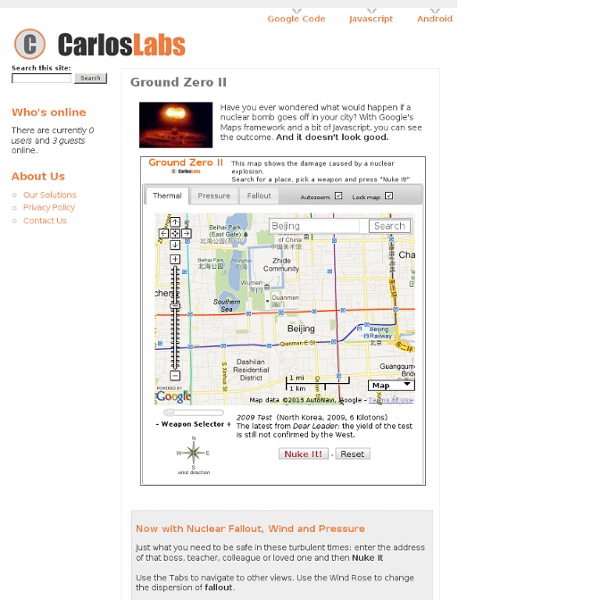Ground Zero II

Slingshot
Instructions: (after you've read these, click here to get a bigger picture.) Click and drag the arrow to change the direction of launch of the spaceship. Choose Jupiter's path distance (the shortest distance of the initial launch point from Jupiter's orbital path) and initial speed of the spaceship. RESET: puts Jupiter into ready position at far left START: Jupiter begins moving at its orbital speed SHOOT: launches the spaceship Zoom in or out to see the full orbit of the spaceship! You can also right-click on the movie and zoom in to get a better view of the objects. Note: Jupiter moves through a distance equal to its diameter in about 3 hours. *** This flashlet demonstrates in a semiquantitative way how a properly directed spaceship can pick up energy from a moving planet. Jupiter Data : Chinese version Copyright © Michael Fowler 2004
Complicated Mechanisms Explained in simple animations - GadgetsWow.com
Author: admin Filed under: General Date: Aug 1,2010 Radial Engines Radial engines are used in aircrafts having propeller connected to the shaft delivering power in order to produce thrust its basic mechanism is as follows Steam engine Principle Steam engine once used in locomotives was based on the reciprocating principle as shown below Sewing Machine Maltese Cross Mechanism this type of mechanism is used in clocks to power the second hand movement. Manual Transmission Mechanism The mechanism also called as “stick shift” is used in cars to change gears mannually Constant Velocity Joint This mechanism is used in the front wheel drive cars Torpedo-Boat destroyer System This system is used to destroy fleet in naval military operations. Rotary Engine Also called as Wankel engine is a type of internal combustion engine has a unique design that converts pressure into rotating motion instead of reciprocating pistons
Animal Sleep
Most animals have a daily pattern of rest and activity. Some animals are more active during the day (diurnal) and some are more active during the night (nocturnal). How much time do animals spend sleeping? References: This table was adapted from four sources: Aserinsky, E., Eyelid condition at birth: relationship to adult mammalian sleep-waking patterns, In Rapid Eye Movement Sleep, edited by B.N.
Imaging maths - Inside the Klein bottle
September 2003 My first practical experience with a Klein bottle was a failure. When I was still at school I came across a picture of a Klein bottle in a weekly journal. I shared my fascination with a friend who was a glassmaker specializing in physics equipment for schools. A few days later I was a proud owner of a physical Klein bottle, made of glass. What to do with such a bottle? To my delight, this primitive but interesting thermometer did indeed show signs of life during the day. The Klein bottle was discovered in 1882 by Felix Klein [1] and since then has joined the gallery of popular mathematical shapes known to the general public outside the "ivory tower". From the Möbius band to the projective plane The Möbius band is the simplest one-sided surface, and is easy to make out of a strip of paper. The band was discovered in 1858 by the German astronomer and mathematician August Ferdinand Möbius. Despite its simplicity the Möbius band was a genuine mathematical discovery. Felix Klein
DaylightMap
A Cartography of the Anthropocene
The Anthropocene: A primer. The Anthropocene. We’re already there. Officially, this epoch does not exist. Unofficially however, the term is used more frequently in the scientific literature and, more recently, in publications dedicated to the general public. So, might you ask, what is the Anthropocene? First, the etymology. The term was proposed in 2000 by Paul J. Technically, the Anthropocene is the most recent period of the Quaternary, succeding to the Holocene. The Pleistocene (2.588 Ma to 11.7 Ka) was a tumultuous era, during which more than eleven major glaciations occurred. The Holocene (11.7 ka until about 1800 AD) was a time comparatively smoother in terms of climate variability. We are officially still in the Holocene. We collectively rolled over into a new era, which includes its stakes and challenges but also its opportunities and great qualities. Here is the definition more or less impressionistic we propose for the Anthropocene: Mapping the Anthropocene: first few steps.
Related:
Related:



